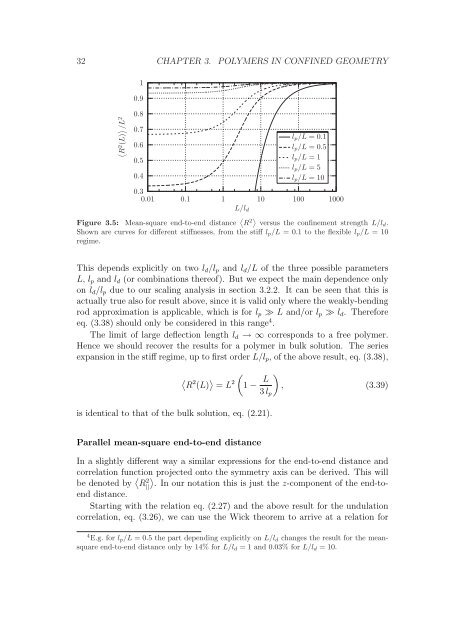Polymers in Confined Geometry.pdf
Polymers in Confined Geometry.pdf
Polymers in Confined Geometry.pdf
Create successful ePaper yourself
Turn your PDF publications into a flip-book with our unique Google optimized e-Paper software.
32 CHAPTER 3. POLYMERS IN CONFINED GEOMETRY<br />
R 2 (L) /L 2<br />
1<br />
0.9<br />
0.8<br />
0.7<br />
0.6<br />
0.5<br />
0.4<br />
0.3<br />
0.01<br />
0.1<br />
1<br />
L/ld<br />
10<br />
lp/L = 0.1<br />
lp/L = 0.5<br />
lp/L = 1<br />
lp/L = 5<br />
lp/L = 10<br />
Figure 3.5: Mean-square end-to-end distance R 2 versus the conf<strong>in</strong>ement strength L/ld.<br />
Shown are curves for different stiffnesses, from the stiff lp/L = 0.1 to the flexible lp/L = 10<br />
regime.<br />
This depends explicitly on two ld/lp and ld/L of the three possible parameters<br />
L, lp and ld (or comb<strong>in</strong>ations thereof). But we expect the ma<strong>in</strong> dependence only<br />
on ld/lp due to our scal<strong>in</strong>g analysis <strong>in</strong> section 3.2.2. It can be seen that this is<br />
actually true also for result above, s<strong>in</strong>ce it is valid only where the weakly-bend<strong>in</strong>g<br />
rod approximation is applicable, which is for lp ≫ L and/or lp ≫ ld. Therefore<br />
eq. (3.38) should only be considered <strong>in</strong> this range 4 .<br />
The limit of large deflection length ld → ∞ corresponds to a free polymer.<br />
Hence we should recover the results for a polymer <strong>in</strong> bulk solution. The series<br />
expansion <strong>in</strong> the stiff regime, up to first order L/lp, of the above result, eq. (3.38),<br />
is identical to that of the bulk solution, eq. (2.21).<br />
Parallel mean-square end-to-end distance<br />
100<br />
1000<br />
<br />
2 2<br />
R (L) = L 1 − L<br />
<br />
, (3.39)<br />
3 lp<br />
In a slightly different way a similar expressions for the end-to-end distance and<br />
correlation function projected onto the symmetry axis can be derived. This will<br />
be denoted by R2 <br />
|| . In our notation this is just the z-component of the end-toend<br />
distance.<br />
Start<strong>in</strong>g with the relation eq. (2.27) and the above result for the undulation<br />
correlation, eq. (3.26), we can use the Wick theorem to arrive at a relation for<br />
4 E.g. for lp/L = 0.5 the part depend<strong>in</strong>g explicitly on L/ld changes the result for the meansquare<br />
end-to-end distance only by 14% for L/ld = 1 and 0.03% for L/ld = 10.













